(This article by Doris Rothauer was published by capito translated into easy language.)
Art can change our lives
The World Health Organization
deals with important health issues,
that affect people all over the world.
For example, there is a program called Art & Health.
This is English and is pronounced like this:
Kind change help.
This means art and health.
Art is good for our brain, our body
and our life in society.
This is what the Art & Health program is about.
The director of the program is Christopher Bailey.
He was first an actor, now he is a researcher.
He and his team are researching
how art influences our lives.
He finds more and more evidence that
that art is good for us.
Art, for example, has these advantages:
- It gives us orientation.
- It strengthens our ability
that we stand up for our rights. - We feel better,
when we experience art. - It gives us more self-awareness.
Christopher Bailey knows this from his own experience.
He has an eye disease.
For some time now he has been unable to see much.

At that time, Christopher Bailey realized:
He has not only lost his eyesight.
He no longer has a place in the world.
He feels excluded.
He has learned,
how he can find his way in the world,
when he doesn't see anything.
But he no longer saw any meaning in life.
Only when he started to deal with art,
he has rediscovered meaning in life.
The Museum of Modern Art
is an important museum in New York.
The museum asked Christopher Bailey,
whether he would like to participate in a podcast.
A podcast is like a radio broadcast on the Internet
on a specific topic.
There are usually several episodes of a podcast.
The Museum of Modern Art
is an important museum in New York.
The museum asked Christopher Bailey,
whether he would like to participate in a podcast.
A podcast is like a radio broadcast on the Internet
on a specific topic.
There are usually several episodes of a podcast.
At first, Christopher Bailey was unsure.
But then he accepted the challenge.
He was amazed when he looked at the picture.
Because Claude Monet painted like this,
how Christopher Bailey sees with his eye disease.
Christopher Bailey noted:
People may find the style beautiful,
how he sees the world.
Christopher Bailey said of the picture:
When I look at the picture, I feel complete.
Everything in the picture merges together.
It can also be understood as
that the past, the future
and the present moment merge together.
I noticed
that I have lost nothing.
I'm not afraid anymore.
I'm just happy about the color and enjoying the moment.
For me, this shows that art can heal.
The right to art and culture
During the Corona period
the cultural institutions were closed,
for example the museums and cinemas.
We had no access to art and culture.
We all realized:
We are missing something,
when we cannot enjoy art and culture.
We don't have that many ideas
and are not so creative.
We feel less joy, happiness and hope.
We get scared
and we become insecure and sad.
This shows:
Art and culture are important,
so that society can develop.
People need art and culture.
Therefore, all people must
Have access to art and culture.
No one should be excluded.
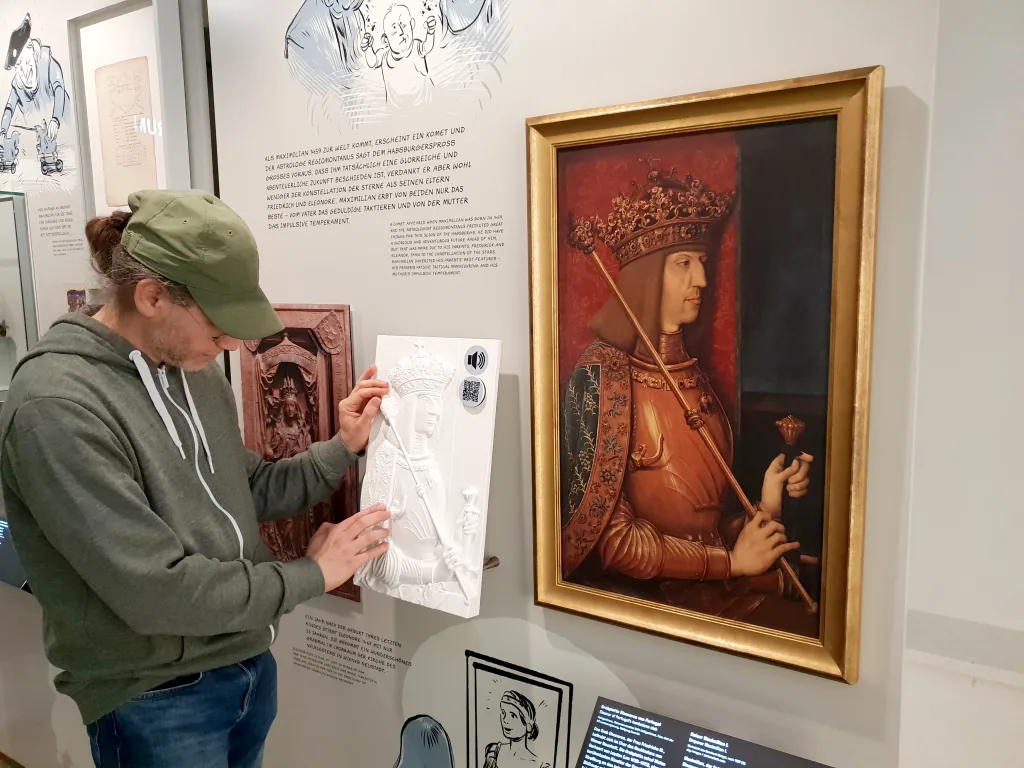
Human rights also state,
that everyone can freely participate in culture.
Everyone can enjoy art.
But the reality is different.
People with disabilities can often
do not participate equally in art.
For example, because the buildings are not barrier-free
or because there are other obstacles.
For example,
that no information in sign language
or in easy language.
Accessibility and inclusion in the museum
What do accessibility and inclusion mean?
All people should have access to art and culture.
To achieve this, museums must be accessible and inclusive.

Accessible means,
that there are no obstacles.
This affects all areas, for example:
- There are no obstacles in buildings,
for example for people in wheelchairs
or people with strollers. - There are no obstacles in the mind.
You think of all people
and excludes no one. - There are no obstacles to living together.
- There are no barriers for people,
who come from other cultures.
Inclusion goes one step further.
Inclusion means
that all People can participate in life in society.
It doesn’t matter,
- what gender they are.
- how old they are.
- where they come from.
- what religion they have.
- what education they have.
- whether they have a disability or not.
In Austria there are laws for accessibility and inclusion:
- The UN Convention on the Rights
of people with disabilities.
This is a treaty between many countries in the world.
It contains the rights of people with disabilities.
Austria has signed the treaty
and must adhere to it. - The Federal Disability Equality Act.
How can a museum be accessible and inclusive?
Accessibility and inclusion concern
many areas in a museum, for example:
- what the building looks like
- how an exhibition is designed
- how the information is conveyed
Different target groups need different things.
An inclusive museum must always
think about all these things.
People who cannot walk well
or who cannot walk at all,
need barrier-free buildings.
These include, for example, the following things:
- There are barrier-free entrances,
for example with ramps and lifts. - The passageways are wide enough for wheelchairs and walking aids.
- Handles are mounted so low,
that you can reach them from a wheelchair. - The ground is smooth and level.
- There are barrier-free parking spaces and barrier-free toilets.
People with hearing impairments
need information they can see.
For example in sign language.
Or they need a hearing system,
that you can connect to your hearing aid.
People with visual impairments
need orientation aids to help them find their way.
These orientation aids must be
be able to see and feel well.
People with visual impairments
also need explanations about the works of art
and about the mood that works of art convey.
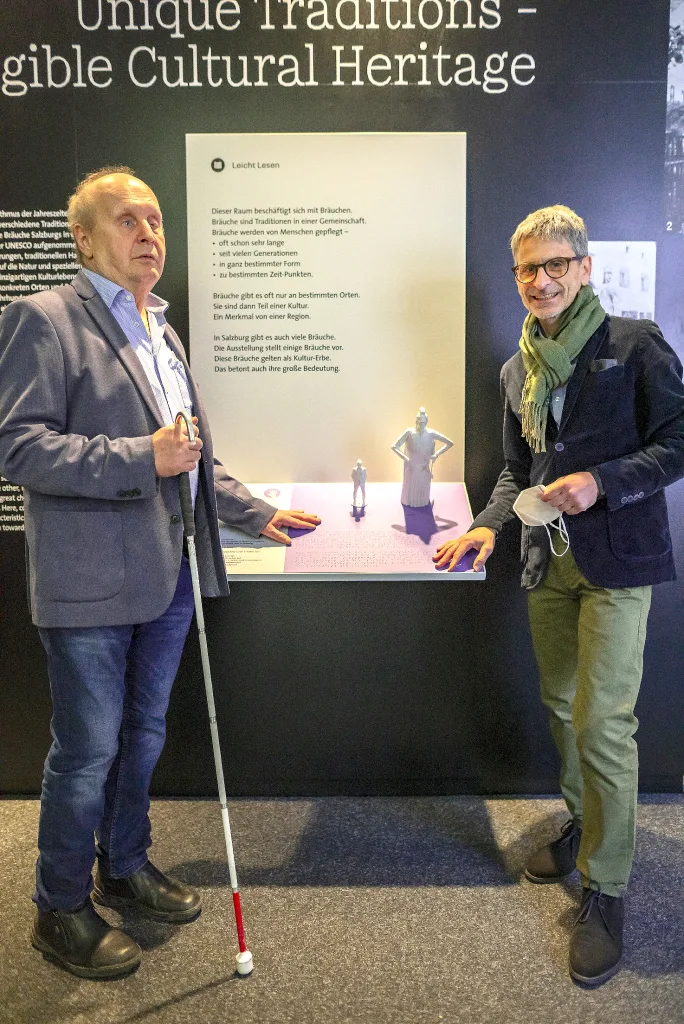
People with learning difficulties
need information in easy language.
These are simple texts
without complicated words and sentences.
It takes a lot of time, money and expertise,
so that a museum becomes inclusive.
Not every museum has enough time and money.
And not every museum has people
who are well versed in it.
Most of the time, museums cannot
become fully inclusive immediately.
They are working on it step by step.
But you can from the beginning
think about accessibility and inclusion.
Then it doesn’t have to be expensive or difficult.
There is also support, for example
from the Inclusive Museum Working Group.
This is a network for museums.
The museums can exchange ideas about projects.
They can share their experience and knowledge
share with other museums.
Because all museums face similar challenges.
In the working group Inclusive Museum
they can solve these challenges together.
Several people founded the working community,
for example Jennie Schellenbacher.
She works at the Vienna Museum.
People with disabilities work with
People with disabilities support museums
It is important that museums not only
above People with disabilities speak,
rather with them.
Rotraut Krall, for example, does this.
She works at the Kunsthistorisches Museum in Vienna
and is an expert on inclusion in museums.
When she started with inclusion,
she got support from a blind person.
Rotraut Krall wanted to describe works of art in such a way,
that even blind people can easily imagine them.
People who have studied art,
often have difficulty with such descriptions.
Because they have to think completely differently,
than they learned it in their studies.
It helped Rotraut Krall a lot,
that she worked with the blind person.
When they were in the museum together for the first time,
They were looking for a work of art for a tactile model.
A tactile model is a small model,
that looks exactly like the work of art.
Blind people can touch it
and thus experience the work of art.
Rotraut Krall described some pictures to the blind person.
Rotraut Krall noticed
what the blind person needs,
so that she can imagine something.
If you practice a lot, you can learn
how to describe works of art well.
It is therefore important
that people from the target group participate.
This idea hasn't been around in museums for very long.
But it works well.
Because this is how museums learn
that there are different types
how people perceive something.
They also learn that people need different things.
In the Kunst-Historisches Museum Vienna
There is now a development team.
Several people work in the team
with different Disabilities.
Rotraut Krall leads the team.
The team shows the museum,
what people with disabilities really need
and that these are completely different things.
The museum learns many new things
and can become even more inclusive.
This would not be possible without the support
not possible for people with disabilities.
People with disabilities work in the museum themselves
But there are not only offers
with people with disabilities,
but also offers from People with disabilities.
These offers go one step further.
People with disabilities do it themselves
Guided tours of museums.
People with disabilities are permanently employed at the museum.
This also changes
how museums think about people with disabilities.
This idea comes from capito Mecklenburg-Western Pomerania.
The interesting thing is:
Offers from people with disabilities
are particularly popular
of people without disability.
Because people with disabilities
have a different view of art.
They show people without disabilities
new ways of seeing art.
They think less about facts
and more feelings.
Experience art independently
There are many possibilities
how to experience art and culture independently.
Technical aids help with this.
With the aids you can decide for yourself
and does not need a person,
which explains something about art.
Touch models of the computer and multimedia guide
Tactile models have been around for a long time.
A tactile model is a small model,
that looks exactly like the work of art.
Blind people can touch it
and thus experience the work of art.
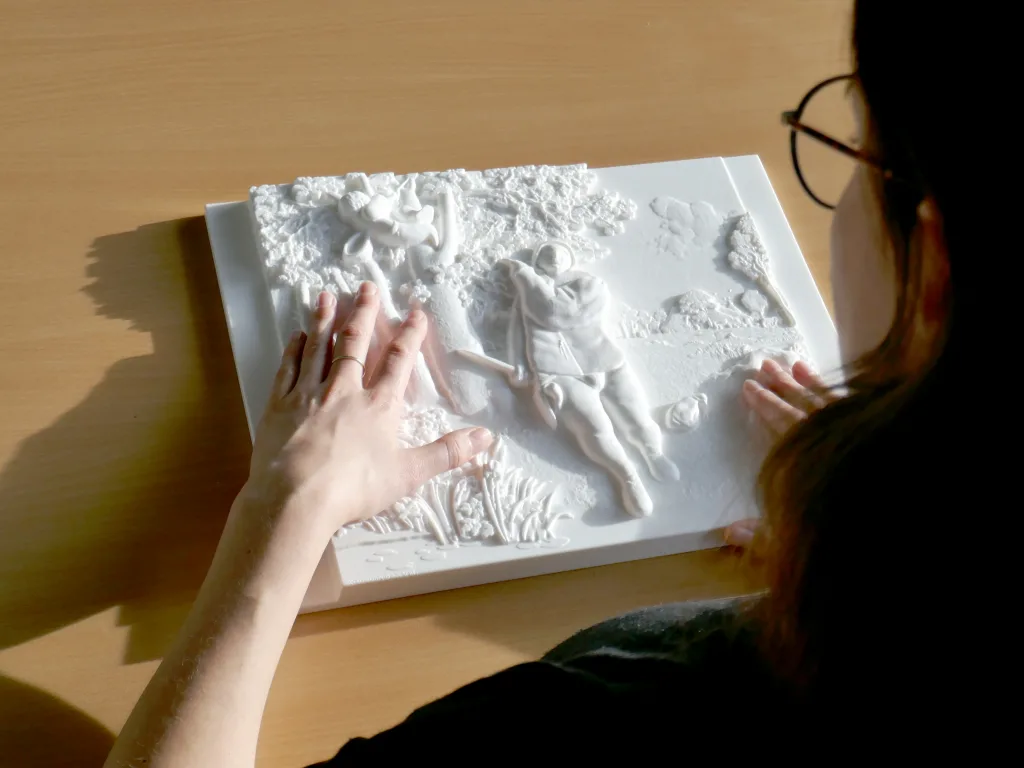
Now there are also tactile models,
that a computer produces.
VRVis develops these tactile models.
VRVis is an Austrian research institution.
The keyboard models from the computer have many advantages.
For example, they form the work of art
very carefully.
In addition, the models can be produced again and again,
because they are stored in the computer.
The most difficult are tactile models of painted pictures.
We see different levels with our eyes,
but the images are flat.
But with the computer you can create tactile models
from the images.
The tactile models then have different levels,
just as you see the levels with your eyes.
Actually, tactile models
made for people with visual impairments.
But they can help everyone
to understand the pictures better.
This applies especially to children
and for people with learning difficulties.
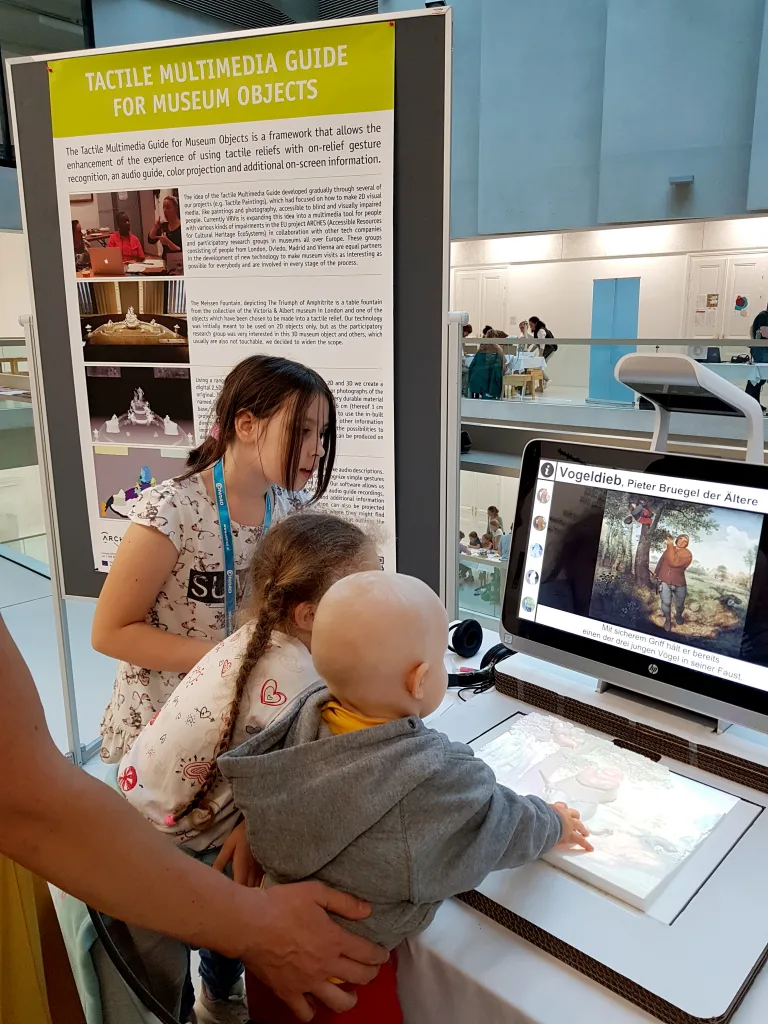
VRVis is constantly working on further possibilities,
how to experience art and culture.
For example, there is a multimedia guide.
The multimedia guide offers many possibilities,
how to experience works of art:
- The works of art move.
- You can listen to the works of art.
- There are explanations to listen to.
- There are descriptions in sign language
and in easy language. - There is more information about the artwork.
Every person can choose for themselves,
how he wants to experience the work of art.
capito app
The capito app is another example,
how to access art using technical aids.
In the app you can enter texts
at different language levels.
Every person can choose
which language level he wants to read.
In this way, different target groups
read and understand the information well.
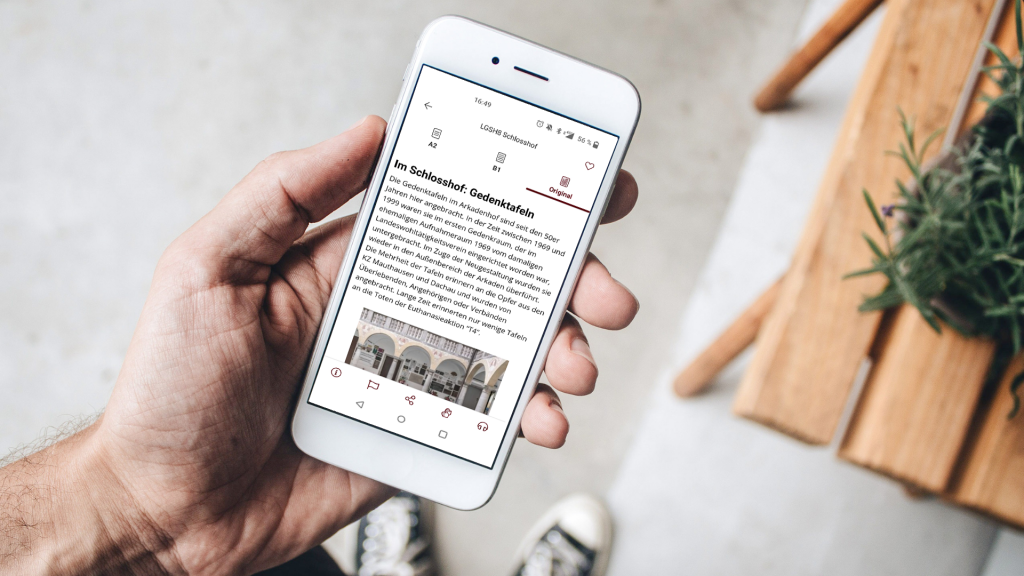
This is very important,
because about half of the people
does not understand the information,
which we receive from authorities and companies.
The capito app has these language levels:
- Language level A1:
This is very simple language.
The sentences are very short and simple.
You only get the most important information. - Language level A2:
This is easy language.
The lyrics are simple, but you also learn new things. - Language level B1:
This is the colloquial language,
that we use in our everyday lives. - Original:
These are texts at higher language levels.
They are difficult to understand.
For the capito app you scan a QR code.
Then you can read the text in the app
or have it read aloud.
You can always switch between language levels.
The right language level depends on various things,
for example:
- how well you can read
- how much you already know about a topic
- what interests you have
If a museum wants to use the capito app,
the museum pays for it.
For the people who visit the museum,
the app is free.
Walburga Fröhlich is the managing director of capito.
She explains,
that the capito app is affordable and has many advantages.
The app means the museum needs
no more audio guides.
People can simply use their smartphones.
This makes the exhibition accessible and easy to understand. The museum can look
which texts people
at which language levels read.
This provides the museum with valuable information
and knows what people need.
Inclusive design for all
Inclusive design means:
You design something like this,
that everyone can use it well.
Doris Prenn is a designer.
She has a design office called prenn_punkt.
There she works particularly on inclusive designs
for exhibitions.
For Doris Prenn, inclusive design means:
When you design an exhibition,
it is a long process.
When it comes to inclusive design, you think
always focus on inclusion throughout the entire process.
This way, as many people as possible can
visit the exhibition well.
Even if they need very different things.
For example, you can
in a museum in Upper Austria:
in the Charlotte Taitl House.
This is a museum about people,
who were killed during the Nazi era.
For example, because they believed in Judaism.
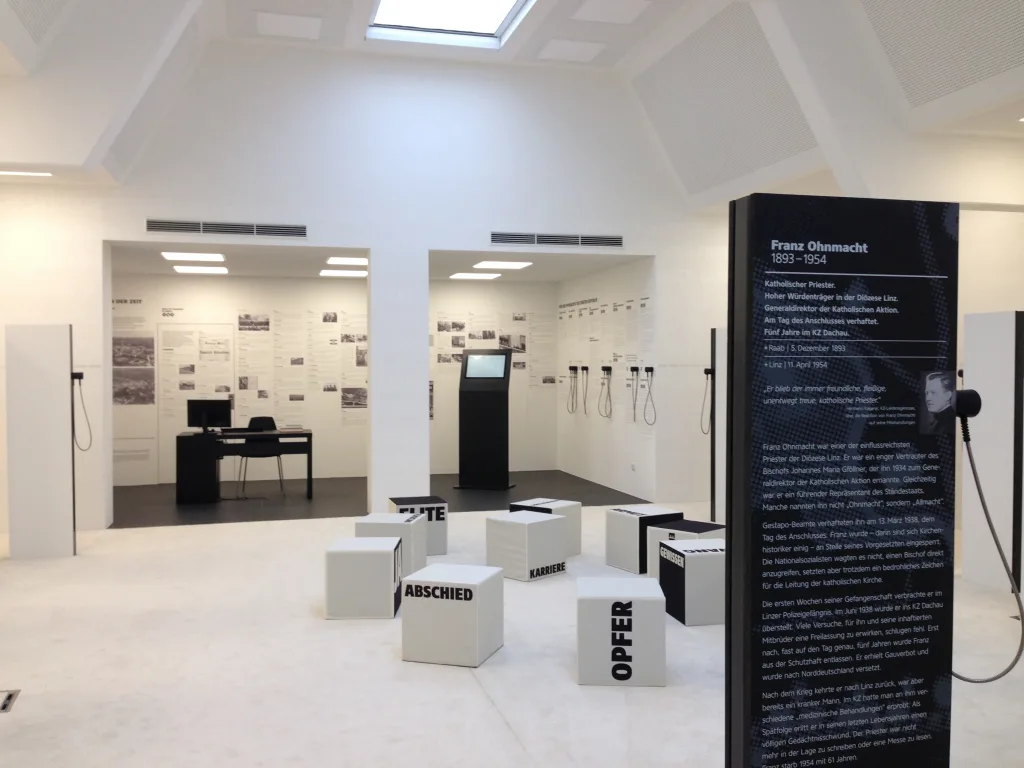
The museum is designed to be very inclusive:
- There is a guidance system in front of the entrance,
that you can see and feel well.
For example, blind people find
or people with visual impairment
good to the entrance. - The writing on the tablets can be seen
and feel.
For example, the data
on which the victims were born
and where they were killed. - There is a museum map at the entrance
for touching. - In the exhibition room all the names of the victims are
in Braille.
Braille is used throughout the entire room.
This is how blind people can orient themselves. - The stories of the victims stand on pillars.
The columns are not jumbled up in the room,
but there is a clear order.
This helps you orient yourself better. - From some photos and documents
There are tactile models. - There are screens,
where you can get additional information. - There is a work station.
There is a computer with internet access
and with a Braille line.
This allows blind people to use computers
read in Braille.
The museum has for the inclusive design
Awards won in 2018:
- the complemento price
from ÖZIV – Federal Association for People with Disabilities - a place on the honor list
from the Inclusion Prize of Lebenshilfe Austria